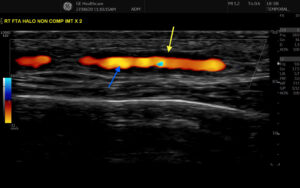Background/Purpose
It has been reported that 20–50% of patients with polymyalgia rheumatica (PMR) have subclinical giant cell arteritis (GCA). The natural history of ultrasound-defined subclinical GCA in PMR is not known.
Methods
Twenty-five newly diagnosed PMR patients who met a clinical diagnosis for PMR, verified by two rheumatologists, were examined by ultrasound. All six branches of the superficial temporal arteries and both axillary arteries were examined using a GE P9 device. Sonographic abnormalities considered indicative of vasculitis in the temporal arteries included the halo sign (see Figure 1) and non-compressible arteries with a thickened intima-media complex. In the axillary arteries, a halo sign and an intima-media thickness of >1.0 mm was considered positive. Follow-up consultations after one year were undertaken to review the clinical diagnoses.

FIGURE 1: Longitudinal view of the frontal branch of the superficial temporal artery, demonstrating a halo sign, as indicated by the anechoic region (yellow arrow) surrounding the inner Doppler (blue arrow) signal. (Click to enlarge.)
In the subclinical GCA group (identified on ultrasound), a PMR-dose steroid taper was used, with a prompt clinical response; a GCA-dose steroid taper was initiated for those who subsequently flared; and tocilizumab was initiated in the event of a second flare.
Results
The cohort consisted of 64% women (n=16) with a mean age of 67 years (range 50–84). 2012 ACR/EULAR classification criteria were met in 16 of 25 patients (primarily due to prior corticosteroid use in primary care, resulting in a normal erythrocyte sedimentation rate [ESR] and C-reactive protein [CRP]).
Five patients (20%) were identified as having subclinical GCA on ultrasound. Of these, all five met 2012 ACR/EULAR PMR classification criteria; none met ACR GCA classification criteria. Temporal artery involvement was identified in those five patients, with axillary involvement in one of the five. The mean halo count was 3 (range 1–5), and the mean halo score was 21.2 (range 17–29). Two patients were managed with an initial PMR-dose of prednisolone but relapsed. Three patients were treated with an initial GCA-dose of steroids—all of whom relapsed.
At a median of 12 months follow-up, one of 20 (5%) of the PMR-only cohort had developed clinical signs of GCA. Five of five (100%) of the subclinical GCA cohort had developed a clinical diagnosis of GCA, with three requiring an increase in steroid dose and two requiring tocilizumab. At 12-month follow-up, none had developed ischemic complications.
Conclusion
Our study indicates that a single screening ultrasound of temporal and axillary arteries accurately identified 83.3% of patients with subclinical GCA in an inception PMR cohort. Our experience indicates these patients are likely to be resistant to PMR-dose steroids and may ultimately require biologic therapy.
The Study Abstract
Presented at ACR Convergence 2022
Kirby C, Flood R, Mullan R, Murphy G, Kane D. Sonographic prevalence of subclinical GCA in newly diagnosed PMR [abstract]. Arthritis Rheumatol. 2022;74(suppl 9).
Disclosures
C. Kirby, none; R. Flood, none; R. Mullan, none; G. Murphy, AbbVie/Abbott; D. Kane, AbbVie/Abbott.


